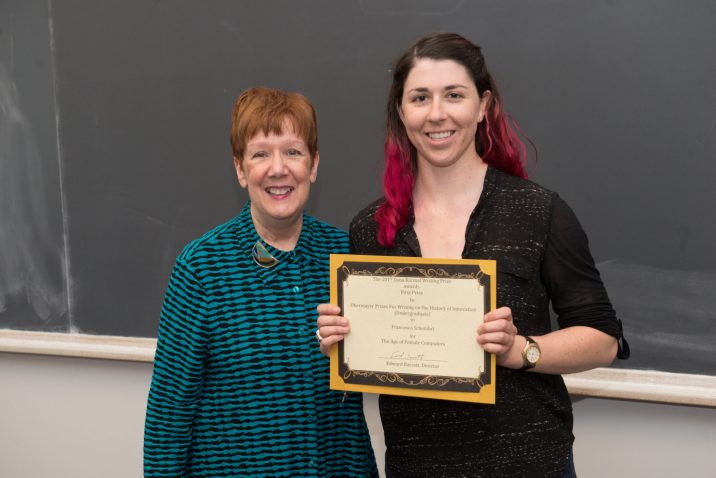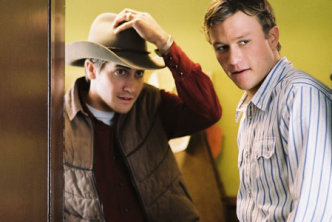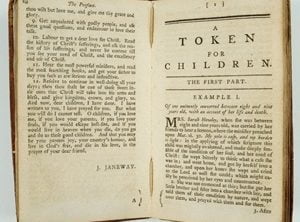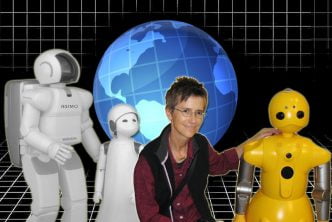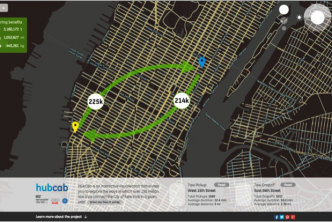“The Age of Female Computers” received the Obermayer Prize For Writing on the History of Innovation, in the undergraduate category.
It is tempting to map the course of human technology as discrete points on a timeline, associating specific dates to major breakthroughs and inventions. Accounts of the history of computing often place a gold star on the evening of February 14th, 1946, marking it as the day on which the first computer was unveiled, and therefore, the start of the computing age. While it is true that on this date John Mauchly, a physics professor at Ursinius College, and J. Presper Eckert Jr., an engineer at the University of Pennsylvania, presented the Electronic Numerical Integrator and Computer (ENIAC) to U.S. Army representatives, February 14th, 1946 neither marked the invention of the first computer nor the beginning of the computing age.[1]
Computers existed before the ENIAC, but they were not the multi-room mazes of wires and tubes used in the 1940s and 1950s, nor were they the sleek laptop machines of aluminum and glass with which most 21st century-users have become intimately familiar. The first “computers” were human beings. The word computer, in the etymological sense, merely denotes “one who computes or calculates,” and, prior to the development of electronic computers like the ENIAC, those who computed in the United States were the men and women working in laboratories, government offices, or for the military.[2] As in the cases of dishwashers, projectors, and many other tasks automated or electrified over the course of history, the prefixes of “electronic,” “digital,” or “automated” are eventually dropped and the new technology inherits the name that the human workers once bore.
Women play a unique role in the American history of the computer as both an electronic machine and a human occupation. It is no coincidence that the first team responsible for programming the ENIAC was entirely female. The six young women were drawn from a pool of computers working, as did thousands of other women, to crunch numbers for the U.S. government and military during World War II. The phenomenon of employing women as computers can be traced back to the mid-18th century and symbolizes a deeper trend of gendered labor divisions in the industrial workforce.[3]
It is also, unfortunately, no coincidence that the female computers responsible for the programming of ENIAC have largely been written out of, or had their roles diminished in, usual retellings of the story behind the first electronic computer. The labor of creating and programming the ENIAC fell along gendered lines, which allowed publicists and historians to attribute most, if not all of the credit, to Mauchly and Eckert, the male builders of the electronic computer. This biased historical perspective on the development of the ENIAC is part of a larger trend in the history of computing, in which women’s accomplishments are downplayed or forgotten, and might have contributed to transforming the field of computer programming into the largely male-dominated area it is today.[4]
By examining the gender politics associated with females working as human computers throughout American history, it is possible to understand why the programmers of the world’s first electronic computer were women, and also to understand why their work has largely been downplayed in historical accounts of ENIAC and the development of the modern computing age.
Women Computers in the U.S. Prior to WWII
The first written record of the word “computer” dates back to English writer Richard Braithwait’s 1613 religious text “The Yong Mans Gleanings:” “I haue read the truest computer of Times, and the best Arithmetician that euer breathed, and he reduceth thy dayes into a short number.”[5] The occupational title “computer” rose to common usage in 17th century Europe as calculus, a new form of mathematics that dealt with bodies in motion and rates of change, emerged with applications in astronomy, engineering, and ship navigation. One of the first major computational endeavors, the prediction of the date of the 1758 return of Halley’s Comet, was carried out in 1757 by three French computers: Alexis-Claude Clairaut, Joseph-Jérôme Le Français de Lalande, and Nicole-Reine Étable de la Brière Lepaute. Lepaute hailed from a wealthy family and had been educated in mathematics by her parents. She married Jean André Lepaute, a royal clockmaker, in 1748, an advantageous marriage that allowed her to practice her skills by assisting her husband with calculations.[6]
Another early female computer, Augusta Ada Byron, Countess of Lovelace, worked with British mathematician and inventor Charles Babbage (considered by many to be “the father of the computer”) on his work creating the first mechanical computers in the 1830s. Lovelace was the only legitimate child of the famous English poet Lord George Gordon Byron and was therefore a member of the wealthy aristocracy. She received extensive tutoring in mathematics and science, and, in 1833, began a long partnership with Babbage and his calculating machines. Babbage’s first machine, the “Difference Engine,” was completed in 1822, and used a hand crank to turn series of cascading gears from a preset starting position to a final answer position using the finite difference method (a mathematical interpolation method in which many calculations can be reduced to simple adding). Lovelace worked as Babbage’s assistant as he wrote plans for a second machine called the “Analytical Engine,” a more complex, general purpose computer that could perform more operations, store numbers, and receive programming instructions from a string of punched cards. Though the machine was never actually built, Babbage and Lovelace spent fifteen years creating detailed engineering plans. In 1843, Lovelace was asked by an English science journal to translate an article on Babbage’s Analytical Engine from French into English, which she did, also adding three times the article’s original length of her own notes. In her annotations, Lovelace invented a method through which the device might handle letters and symbols along with numbers through punch card codes. She also created a method for the Engine to repeat a series of instructions, foreshadowing a process known as looping that computer programs use today. Although often less celebrated than Babbage for her work in computing, Lovelace is considered by many historians to be the first computer programmer.[7]
On the other side of the Atlantic, the Second Industrial Revolution was sweeping across the United States, bringing with it new forms of communication and transportation, and, by consequence, the demand for more computers. The telegraph wires and train tracks followed the soldiers of the Civil War as they marched south and west. When the collection of weather data and surveying resumed in the years following the war, the U.S. government was overwhelmed with information coded into telegraphs. In 1870, the Army Signal Corps, the U.S. Naval Observatory, and the Coast Survey began hiring large staffs of computers to perform calculations on the incoming data and prepare it for distribution. Women began breaking into these computing rooms in the two decades following the Civil War. Unlike their predecessors Lovelace and Lepaute, these American female computers did not hail from wealthy families, nor did they have world-class educations or affluent husbands and friends. As associate professor of technological policy David Alan Grier writes in When Computers Were Human: “They were workers, desk laborers, who were earning their way in this world with their skill at numbers.”[8]
Grier goes on to comment on how the nature of American business had evolved and expanded during the Civil War, opening up more divisions within the labor force and, therefore, more opportunities for women:
Business skills were taught in high schools [in the late 1860s], a new innovation in public education. These skills were similar to those needed by human computers, though clerks did not need to understand the calculus of Newton. Both clerks and computers were subordinate to a professional staff, both were paid a small wage, and both handled routine work.[9]
Anna Winlock was one such computer, hired in 1875 by the Harvard Observatory to do computations on their unreduced observations for 25 cents an hour. By placing computers on the clerical tier and with women willing to accept low pay for their work, the Observatory and other organizations began to hire women as computers. By 1880, all of the computers working at the Harvard Observatory were female and had been hired by director Edward C. Pickering. The group was referred to, somewhat crudely, as “Pickering’s Harem,” signifying the beginnings of computation being gendered as female.[10] Shortly after hiring his staff, Pickering purchased a carpet for the computation room, a gesture Grier sees as more than just one of goodwill:
[T]he carpet was also a symbol of divided labor, or tasks for men and women. The literature of the time talks of separate spheres for the two genders, a metaphor that borrows from the classical model of astronomy…men could move freely through the observatory, even up into the telescope room…the women had their computing room, with its desks and its carpet.[11]
This gendering of labor would continue through the turn of the 20th century and into World War I. This new form of warfare, total war, mobilized entire countries – economies, governments, and citizens alike. Computing was leveraged to solve two kinds of problems: military calculations for artillery trajectories and atmospheric drag, and economic problems concerning production, as the United States strove to organize and arm its troops. All of the computing for ballistics of anti-aircraft munitions was handled at the Aberdeen Proving Ground in Maryland, the U.S. army’s ballistics testing and research site.[12]
As men were drafted and shipped off for combat duty, women were actively recruited into the workforce to fill the labor shortage, including as computers. However, as historian of science Margaret Rossiter explains in Women Scientists in America: Struggles and Strategies to 1940, “despite incursions into a few areas of ‘men’s work’ that were facing desperate shortage … most were called into traditional and new areas of ‘women’s work’ related to the war effort.”[13] Rossiter argues that despite an unprecedented number of women holding jobs in 1917, wartime employment mostly reinforced the gendered division of labor. Computers’ work was already seen as a subset of clerical work, so women were allowed to occupy these positions in greater numbers, but had little to no possibility of lateral movement within the organization. In the mid-1930s, while women were permitted to work as computers in laboratories at universities such as Columbia and Princeton, they work under male scientists and engineers who conducted the actual research.[14] This trend would continue to dominate the United States’ preparation for another total war two decades later.[15]
The Philadelphia Computing Section
When the United States officially entered World War II in December 1941, the massive industrial society shifted once again into wartime production mode. Major advances had occurred in many forms of weaponry, particularly ballistics and airborne weapons, and the Army needed updated calculations. The Ordnance Department at Aberdeen could not keep pace and, as a result, established a classified satellite laboratory at the University of Pennsylvania’s Moore School of Engineering. The laboratory recruited around 80 mathematically proficient, college-educated women in 1942 as computers, forming the Philadelphia Computing Section (PCS).[16] Working in three shifts, the women performed complex calculations to solve for the firing tables of rockets and artillery shells. The computers did most calculations by hand or used slide rules and large, clunky Marchant and Monroe-brand desktop calculators that made errors and required frequent calibration. The laboratory also owned a differential analyzer, a machine developed a decade earlier by Harold Locke Hazen and Vannevar Bush at MIT, that used wheel-and-disc mechanisms to solve differential equations through integration, but it too needed frequent recalibration.[17]
One of the first computers hired by the PCS was Kathleen McNulty, who had earned a degree in mathematics in 1942 and applied for the position with her friend Francis Bilas. McNulty described their work solving differential equations (formulae when one or more of the variables are changing at a certain rate) through a process known as numerical integration:
Numerical integration is where you take … [the] path of a bullet from the time it leaves the muzzle of the gun until it reaches the ground. It is a very complex equation; it has about fifteen multiplications and a square root … you have to find out where the bullet is every tenth of a second from the time it leaves the muzzle of the gun, and you have to take into account all the things that are going to affect the path of the bullet.[18]
The results of the numerical integration formulae were then entered into ballistics table for every conceivable firing angle, distance, velocity, and weather condition, and sent directly to soldiers at the front. As new weapons rolled off assembly lines at a breakneck pace, new ballistic tables needed to be computed quickly. Accuracy in ballistics firing and bomb dropping in a variety of conditions across Europe was critical to the American war effort. As official employees of the U.S. Army and concerned citizens, the women felt the urgency in their computations. Shirley Blumberg Melvin, a computer at the PCS, said that while they “usually had enough women working those three shifts to get the project done in time, but if we weren’t finished in time, we doubled shifted.”[19]
Despite the fact that the computer work was as challenging as it was vitally important for American troops at the front, gendered labor standards still classified it as clerical and subordinate to the work being done by the supervising male engineers. A 1942 memorandum from the National Advisory Committee for Aeronautics (NACA) illustrates how many government organizations viewed the role of female computers:
It is felt that enough greater return is obtained by freeing the engineers from calculating detail to overcome any increased expenses in the computers’ salaries. The engineers admit themselves that the girl computers do the work more rapidly and accurately than they would. This is due in large measure to the feeling among the engineers that their college and industrial experience is being wasted and thwarted by mere repetitive calculation.[20]
By labeling challenging albeit repetitive calculation as something that would waste the time and potential of male engineers and supervisors, organizations diminished the work of the women at PCS and other female computers. Women were regarded as having little potential for roles beyond the clerical sphere and were kept in occupations that minimized their achievements. In Gender Politics in WWII, professor of sociology Ruth Milkman argues that the women of the PCS and other cohorts of female computers were lumped together, as “the girl computers” or “Philadelphia’s girls,” in a way that erased their identities and allowed men to see them as faceless resources in the same way they would see a shipment of slide-rules or microscopes. Male engineers inventing new ballistics weaponry and male soldiers at the front received acclaim and publicity for their efforts. McNulty, Melvin, and other computers at the PCS would not get their names printed on the ballistics tables they helped to create.[21]
In the spring of 1943, John Mauchly, assistant professor of electric engineering at the Moore School, researching weather prediction, was searching for a way to automate his laborious calculations. After meeting engineering graduate student J. Presper Eckert, the two drafted plans for an electronic, digital calculator capable of many forms of computation. The pair proposed their idea to Captain Herman Goldstine, a young mathematician in charge of the ballistics tables at the PCS and Aberdeen, who was immediately enthusiastic about its applications in his department. The team secured Army funding and began working on the Electronic Numerical Integrator and Computer (ENIAC) in July 1943 at the Moore School. [22]
Ten of the Moore’s faculty members in engineering were assigned to the ENIAC project, and would design and construct the machine over the course of three years. The ENIAC worked by connecting hundreds of adding machines with electrical wire, and then sending electrical current through a maze of switches and vacuum tubes that made up the various mathematical equations. When the current was directed through a particular switch, the machine would turn on a light on a number column, indicating that that particular number would be part of the final answer. [23]
Once a problem calculation was initiated in the machine, the ENIAC could churn out the answer much faster than the computers working by hand on the upper floors of the Moore School. The limiting factor in the ENIAC’s speed was setting up the initial conditions of calculation. While later electronic computers would read inputs on a string of punched out cards fed into them, the ENIAC had to be set by plugging in wires to around 40 plug boards in the specific locations that denoted the initial conditions. [24]
While the engineers on Mauchly and Eckert’s machine worked to get the mechanical side up and running, they need a team to program the machine every time it was needed to run a calculation, as the ENIAC had no central memory until 1953. Before then, it relied on a series of twenty accumulators, each of which could store only one 10-digit decimal number. The team drew from the pool of computers at the PCS just a couple floors above them.
In When Computers Were Women, MIT Professor of Science, Technology, and Society Jennifer S. Light comments on the unique situation:
Six of them were selected to program a machine that, ironically, would take their name and replace them, a machine whose technical expertise would become vastly more celebrated than their own.[25]
The six computers chosen were Kathleen McNulty Antonelli, Jean Jennings Bartik, Betty Snyder Holberton, Marlyn Wescoff Meltzer, Frances Bilas Spence, and Ruth Lichterman Teitelbaum. Since the project was run under time pressure, the women did not receive much formal training on the ENIAC and had to learn many elements on the job.[26]
In her autobiography Pioneer Programmer, Jean Jennings Bartik refers to the ENIAC as “a bitch to program.”[27] Not only did the women need to correctly connect thousands of wires to set up the machine for a run, they had to verify where things were going wrong any time the machine computed an error, a process that became known as “debugging.” The ENIAC’s operation relied on nearly 18,000 vacuum tubes, which were notoriously prone to burning out during testing; several needed to be replaced every time a run was initiated. The ENIAC’s programmers not only became experts at programming the machine to run complex problems, they were intimately familiar with its inner workings, often crawling inside the machine to locate a burned out vacuum tube or wire. The ENIAC could run partial calculations in stages, allowing the women to follow along with the computations and determine where the source of the error was located.[28]
World War II had ended before the ENIAC was complete, but the U.S. had new conflict with the Soviet Union brewing, and so the ENIAC’s official demonstration calculation involved the path of a hydrogen bomb. Jean Jennings Bartik recalls that on the eve of the ENIAC’s planned unveiling and demonstration to Army officials, there was a major issue with the calculations:
Betty [Snyder Holberton] and I, were worked night and day so that everything was hunky-dory until the night before the demonstration. The shell didn’t stop when it hit the ground. It dug a hole. We couldn’t figure out what on Earth was going wrong. So I’ve always said that Betty uses more logic in her sleep than most people do awake. So that night, she had her nighttime logic working and the next morning she came in and knew exactly which switch on the master programmer to change to stop it when it hit the ground. So, it was a fantastic demonstration.[29]
Gendered Labor, Gendered Representation
The demonstration on February 14th, 1946 was indeed fantastic, and the Army spared no expense with a three-course meal and photographers. The women who worked tirelessly to make sure the demonstration actually occurred, however, were not invited to the dinner, nor were their names listed in documents from the evening. They were instead lumped together as “the ENIAC operators.” Bartik, McNulty, and the other women of the ENIAC were similarly excluded from any press releases, articles, or publicity materials associated with the invention, which would soon become a sensation. War Department press releases gave credit only to the three men in charge of the project: “primarily responsible for the extremely difficult technical phases of work … Eckert – engineering and design; Mauchly – fundamental ideas; Goldstine – mathematics, technical liason.”[30]
Newspaper and popular media showed similar allocation of credit for the ENIAC. An article in the New York Times on February 15th, 1946 explained that the ENIAC could “solve a difficult problem that would have required several weeks’ work by a trained man. The ENIAC did it in exactly 15 seconds” and had the machine not been invented “the job [of computing] would have kept busy 100 trained men for a whole year.”[31] This account not only erases the many hours of work that the programmers did in setting up the machine in order for it to be able to run in 15 seconds, but also gives the impression that only men were working as computers during the War. The PCS and other Army organizations employed almost exclusively female computers. Press photographs also mostly depicted Mauchly, Eckert, Goldstine, or male operators standing in front of the machine.[32]
Margaret Rossiter’s 1993 article The Matilda Effect in Science, describes the phenomenon in which women’s accomplishment are often left out of the history of science and technology:
Individuals at the top of professional hierarchies receive repeated publicity and become part of historical records, while subordinates do not and quickly drop from historical memory. [33]
While the women of the ENIAC and other female computers had made major contributions to the advancement of wartime and computer technology, their positions were still subordinate and the role of computer was still inextricably tied to clerical work. The gendering of labor also stacked the deck against the female computers. The male engineers and supervisors produced tangible deliverables: machines, weapons, organizations of human beings, and mechanical devices. The female computers produced numbers on a page to be catalogued. The laborious calculations and hours of crunching numbers were hidden in the finished product, as were their names. Even when the team of women programmed the ENIAC, they marked the beginning between computer “hardware” and computer “software.” Their tireless work setting up and debugging the ENIAC was intangible, and to all who observed the machine running full speed, invisible.[34]
The Legacy of the Women of the ENIAC
The ENIAC was undoubtedly a technological turning point in the history of computing and a sensation that ushered in what would become known as the Computer Age. Its invention, however, did not break away from the trend of minimizing women’s accomplishments in science and technology. The women who served as WWII computers and helped to program the first electronic computer were, until recently, written out of historical accounts. Jennifer Light summarizes the deeper meaning behind this removal:
The result is a distorted history of technological development that has rendered women’s contributions invisible and promoted a diminished view of women’s capabilities in this field. These incomplete stories emphasize the notion that programming and coding are, and were, masculine activities.[35]
Although women were encouraged by the Army and other organizations to return home after their wartime employment was terminated, many of the women of the ENIAC and the PCS found ways to remain in the field. Jean Jennings Bartik continued to work with Eckert and Mauchly on the BINAC and UNIVAC I computers, and later worked at a publisher of technological research. In 1953, Betty Snyder Holberton became a supervisor of advanced programming at the Navy’s Applied Math lab in Maryland, and later worked on programming languages at the National Bureau of Standards. In 1997, the six original ENIAC programmers were inducted into the Women in Technology International Hall of Fame.[36]
While it is tempting to map the course of human technology as discrete points on a timeline, voices and faces are often forgotten in the process. In the case of the history of computing and of the ENIAC, it was the female computers who worked tirelessly to help give life to the computers we know and use today. The gendered division of labor diminished their important, and challenging, work as computers and as programmers to merely clerical, “women’s work.” In more recent accounts, however, the women computers are being re-written into their own history. As computer technology continues to permeate modern life, it will be critically important to remember women’s place within its development, in the past, in the present, and hopefully, in the years to come.
Works Cited
Bartik, Jean Jennings. Pioneer Programmer: Jean Jennings Bartik and the Computer that Changed the World. Kirksville, MO: Truman State University Press. 2013. Print.
Grier, David Alan. When Computers Were Human. Princeton, NJ: Princeton University Press. 2005. Print.
Light, Jennifer S. “When Computers Were Women.” Technology and Culture 40, no.3 (1999): 455-83.
Milkman, Ruth. Gender at Work: The Dynamics of Job Segregation by Sex During World War II. Chicago, 1987.
McCarthy, Scott. ENIAC. New York, NY: Walker Publishing Company. 1999. Print.
Rossiter, Margaret. “The Matilda Effect in Science,” Social Studies of Science 23 (1993): 325-41.
Rossiter, Margaret. Women Scientists in America: Struggles and Strategies to 1940. Baltimore, MD: The Johns Hopkins University Press. 1982. Print.
Top Secret Rosies: The Female Computers of WWII. Dir: Leanne Erickson. PBS. 2010. Film.
Endnotes
- McCartney, Scott. ENIAC. New York, NY: (Walker Publishing Company, 1999), 130 ↑
- Grier, David Alan. When Computers Were Human. Princenton, NJ: (Princeton University Press. 2005), 14-20 ↑
- Grier. 67-70 ↑
- Light, Jennifer. “When Computers Were Women.” Technology and Culture 40, no.3 (1999): 455-83. ↑
- Grier. 10 ↑
- Grier. 16-25 ↑
- Grier. 89-96 ↑
- Grier. 120-124 ↑
- Grier. 133 ↑
- Grier. 141 ↑
- Grier. 146 ↑
- McCartney, 68-75 ↑
- Rossiter, Margaret. Women Scientists in America: Struggles and Strategies to 1940. Baltimore, MD: (The Johns Hopkins University Press, 1982) 119 ↑
- Grier. 208-210 ↑
- Rossiter. 124-132 ↑
- Top Secret Rosies: The Female Computers of WWII. Dir: Leanne Erickson. PBS. 2010. Film. ↑
- Light, Jennifer. “When Computers Were Women.” Technology and Culture 40, no.3 (1999): 455-83. ↑
- Top Secret Rosies. ↑
- Top Secret Rosies. ↑
- Light, Jennifer S. “When Computers Were Women.” Technology and Culture 40, no.3 (1999): 455-83. ↑
- Milkman, Ruth. Gender at Work: The Dynamics of Job Segregation by Sex During World War II. (Chicago, 1987) 46-50 ↑
- McCartney. 183-191 ↑
- McCartney. 194-202 ↑
- McCartney. 207 ↑
- Light, Jennifer S. “When Computers Were Women.” Technology and Culture 40, no.3 (1999): 455-83. ↑
- Grier. 237 ↑
- Bartik, Jean Jennings. Pioneer Programmer: Jean Jennings Bartik and the Computer that Changed the World. Kirksville, MO: (Truman State University Press, 2013) 136 ↑
- Top Secret Rosies. ↑
- Top Secret Rosies ↑
- Light, Jennifer S. “When Computers Were Women.” Technology and Culture 40, no.3 (1999): 455-83. ↑
- Light, Jennifer S. “When Computers Were Women.” Technology and Culture 40, no.3 (1999): 455-83. ↑
- McCartney. 245, 260, 305 ↑
- Rossiter, Margaret. “The Matilda Effect in Science,” Social Studies of Science 23 (1993): 325-41. ↑
- Light, Jennifer S. “When Computers Were Women.” Technology and Culture 40, no.3 (1999): 455-83. ↑
- Light, Jennifer S. “When Computers Were Women.” Technology and Culture 40, no.3 (1999): 455-83. ↑
- Bartik, Jean Jennings. Pioneer Programmer: Jean Jennings Bartik and the Computer that Changed the World. Kirksville, MO: (Truman State University Press, 2013) 290-316 ↑

